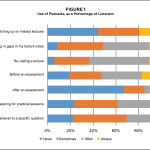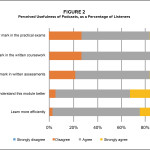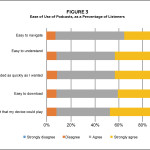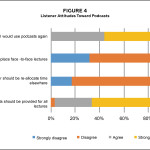A Pilot Study of Optometry Student Perceptions, Acceptance and Use of Podcasting
Kirsten Hamilton-Maxwell, PhD, B.Optom(Hons), FHEA
Abstract
Background: Students undertaking a clinical module in optometry were provided with lecture podcasts as a supplement to conventional teaching. This research sought to evaluate student perceptions of podcasting. Methods: Students (n=83) who had received podcasts in the previous academic year completed a survey based on the Technology Acceptance Model. The survey evaluated usage patterns, perceived usefulness, ease of use, attitudes to podcasts and barriers to engagement. Results: The acceptance and uptake of podcasts were encouraging. Perceived benefits included improved understanding, learning efficiency and performance in assessments. Barriers to use included a preference for other learning methods, unfamiliarity with podcasts and lack of time. Conclusion: Podcasts were a popular supplement to traditional clinical teaching methods in optometry.
Key Words: podcast, higher education, optometry, undergraduate
Background
“Lecture capture” is a process in which digital recordings of live lectures are shared with students. Its purpose is to increase engagement with lecture material and to increase student satisfaction.1 “Full” lecture capture includes video and audio,2,3 but it can be challenging to introduce because it requires suitable infrastructure such as cameras and microphones in lecture theaters and upgrades to computer hardware. Working with video files can be time-consuming for staff and requires technical expertise. Finally, video files are large, so students without a good quality internet connection may find them difficult to access.2,4
A more accessible alternative to full lecture capture is “podcasting.” The term “podcast” is defined as “a digital audio file of speech, music, broadcast material, etc., made available on the Internet for downloading to a computer or portable media player; a series of such files, new installments of which can be received by subscribers automatically.”5 The average smartphone, tablet or computer can record and edit high-quality audio, which common e-learning platforms can then distribute as a podcast. The flexibility of audio allows podcasts to be updated as needed,6 maintaining the relevance to students.3,7,8
Podcasts are used to support learning in a wide range of healthcare disciplines, including medicine,3,9-11 nursing2,4,7,12-15 and dentistry.16 The most common use has been to support students with basic science and pre-clinical modules.2,7,9,10,12,16 Use of podcasts for undergraduate clinical education is rare,15 and there are no documented cases in optometry.
Podcasting is popular with students and can increase student satisfaction and engagement.6,11,13,17,18 This popularity stems from perceived benefits including mobility4,6,7,12,14,15,19-21 and flexibility.2,4,7,13,19-22 Students value the ability to re-visit lectures and revise lecture notes,2-4,6,7,9,12,14,17,18,21,23,24 which may also help to reduce anxiety.6,10,15,16 Finally, auditory learners may appreciate learning resources in an audio format.3,11-15,19,21
Even though students believe that podcasts can improve academic performance,2,4,7,10,13,16,17,21 evidence of an objective improvement is lacking.4,13,17,25 This may be because lecture podcasts may duplicate,25 or replace,17 traditional teaching resources. The flexibility of “on demand” resources can also pose risks. For example, the mobility of podcasts can interfere with concentration by encouraging listening in distracting environments.13,17,26 The ability to choose when to study may allow students to pace their learning inappropriately.4 Concerns have also been raised about the effect of podcasts on lecture attendance4,21,23 because non-attendance may increase the likelihood of poor academic performance, disengagement and discontinuation.17,21,27 Non-attendance in clinical modules may be riskier due to the visual nature of procedural instruction.2 Despite these concerns, podcasting in other courses has caused little to no decrease in the number of attendees in most cases.4,6,7,10,15,16,21,24
There are many ways to measure academic progress in higher education. Final outcome measures such as grades are important, but it is also essential to understand and optimize the individual factors that contribute to the overall academic success of a student; these include student engagement and satisfaction.28 The purpose of this study was to assess participant perceptions of a podcasting pilot program in optometry.
Methods
Participants and ethics
In the first week of the new academic year, a printed survey was distributed to all Year 2 students (n=83). Seventy-one of the respondents (85.5%) indicated that they had completed the OP1201 Basic Clinical Techniques module, undergraduate optometry program, Cardiff University, in the previous academic year. OP1201 is a compulsory 22-week module that equips Year 1 students with the clinical skills and knowledge required to conduct a basic optometric eye examination; it assumes no prior experience. The module is taught using one-hour lectures and two-hour practical (clinical) classes. The theory and technique for each clinical procedure are described in one or more lectures, and the procedure is later performed by students in a practical class under the guidance of qualified optometrists. All PowerPoint presentations delivered in the lectures, as well as additional written information and revision exercises, were published online (Blackboard™) before face-to-face sessions. Students who had completed the OP1201 module in the previous year but who had not progressed to Year 2 (n=7), or who were attempting Year 2 for the second time (n=2), were not captured by this study.
The Research Audit Ethics Committee at the School of Optometry and Vision Sciences, Cardiff University, granted ethical approval for this study, and the research was conducted in accordance with the tenants of the Declaration of Helsinki. Potential participants were informed of the nature of the study verbally and in writing, and consent was implied by submission of a completed survey. As a condition of ethical approval, the participants were informed that their opinions would be considered when determining the future of the podcasting pilot program. To limit the possibility of systematic bias as a result of being aware of the study’s purpose, students were presented with the full range of potential outcomes verbally and through the survey questions.
Survey design
The survey design was based on the Technology Acceptance Model (TAM),29,30 a method used previously to assess the student perceptions of podcasting in higher education.12,17,22 The TAM considers a broad range of issues, including current usage patterns, barriers to use and untapped potential. This survey also contained questions directed towards students who had not used the podcasts.3 The final survey consisted of a mixture of four-point Likert scale questions and questions in an open-ended format and was conducted anonymously. Local nomenclature required that the word “practical” be used on the surveys rather than the word “clinical,” although these terms are interchangeable for the purposes of this study.
Podcast production
The podcasts were recorded during lectures for the OP1201 module using the native Voice Recorder app (version 0.1) and built-in microphone of a Samsung Galaxy SIII smartphone placed on the lectern. The recordings were transferred to a computer for conversion from the proprietary 3gp format to generic mp3 using Format Factory for Windows (version 2.96, available for free at https://www.pcfreetime.com). The mp3 was edited using Audacity for Windows (version 2.0.2, available for free at https://audacity.sourceforge.net/) to remove unnecessary material at the start and end of the lecture. Each podcast was uploaded to the online learning platform Blackboard™(version 9) using the plug-in “Campus Pack Podcasts” within two weeks of the lecture, where it could be downloaded manually or via a podcast subscription service. Students were advised that podcasts were intended to accompany the PowerPoint presentation delivered in the lecture.
Data analysis
The responses to all survey questions were summarized and presented using Microsoft Excel 2013 for Windows. For each question, the proportion of responses for each category on the Likert scale was calculated as a percentage of the number of total valid responses. Responses to open questions are presented as quotations in this paper, as there were too few to conduct a thematic analysis.
Results
Use of podcasts
52.1% (37/71) of the participants stated they had downloaded and listened to at least one podcast; they are referred to as “Listeners.” The remaining 47.9% (34/71) did not listen to any podcasts; they are referred to as “Non-listeners.”
Listeners
Of the Listeners (n=37), 100% had used a computer to access the podcasts. Mobile devices, such as dedicated portable audio players (8.1%), smartphones (8.1%) and tablet computers (2.7%), were used sparingly. Figure 1 shows that the primary use of podcasts by Listeners (defined as “often” or “always”) was for filling in gaps (51.3%) and re-visiting (63.9%) lectures. Podcasts were used frequently before assessment tasks (52.8%) but less commonly afterward (14.7%). Some Listeners routinely used podcasts to prepare for practical sessions (38.3%). Among the Listeners, 36.1% reported using podcasts to catch up on missed lectures “sometimes,” while 19.4% reported that they “always” did so.
Figure 2 shows that most Listeners agreed or strongly agreed that podcasts increased understanding (94.6%) and learning efficiency (97.3%). Many Listeners felt that their academic performance in practical (73%) and written coursework or assessments (73% and 78.4%) was enhanced by the podcasts, as indicated by the level of agreement with survey questions relating to obtaining a “better mark.”
Figure 3 shows that Listeners agreed or strongly agreed that the podcasts were easy to navigate (91.9%), understand (91.8%), download (91.9%), were uploaded quickly (91.5%) and were in a useful format (91.5%). A small number of Listeners (<9%) reported minor difficulties with accessing or using the podcasts.
Non-listeners
The main reasons that Non-listeners did not use podcasts were a lack of familiarity with accessing material in this way (34.3%), a lack of time (31.4%) and dislike of accessing or using them (28.6%). Minor reasons included technical difficulties (2.9%) and a lack of awareness of podcasts (2.9%).
Figures 4 and 5 show that the majority of participants (97.3% of Listeners and 80.7% of Non-listeners) agreed or strongly agreed that podcasts should be provided for all lectures and expressed a desire to use them in the future (100% of Listeners and 63.4% of Non-listeners). Both groups agreed that the preparation of podcasts was a good use of lecturer time (82.8% of Listeners and 80% of Non-listeners). In response to the question of whether podcasts would be a suitable replacement for face-to-face lectures, 85.7% of Listeners and 83.9% of Non-listeners disagreed.
Discussion
Although podcasting has been used in healthcare education for some time, its main function has been to support the teaching of basic science and pre-clinical modules.2,7,9,10,12,16 Little is known about the use of podcasts for clinical education,15 and nothing on the topic and optometry had been published. This study explored the introduction of podcasts in optometric education from a student perspective and found podcasts to be a popular supplement to traditional clinical teaching.
Use of podcasts
Approximately half of the survey respondents (52.1%) reported listening to at least one podcast, with a significant proportion using podcasts frequently (“often” or “always,” Figure 1). The uptake of podcasts in this study is similar to the prevalence of Listeners reported within other Year 1 UK-based healthcare education courses, including 64.6% and 51.5% for two basic science modules in a medical degree program at the University of Leeds,9 and 71% reported at the University of Nottingham for Nursing students studying a biology module.12 The number of students accessing podcasts in this study was considerably lower than figures reported by institutions in the United States, such as the 89.4% reported in a basic science course at the Vanderbilt University School of Medicine,10 and the 95% reported at the School of Nursing at Adelphi University.7 These figures suggest podcasts were well-accepted by optometry students but there may be potential for increasing adoption.
Smartphones and tablets have not changed listening habits
One of the original benefits of podcasting was the flexibility it offered, allowing students to study anywhere and at any time.13,17,26 Research has since shown that most students prioritize the ability to concentrate over the ability to be mobile,4,6,7,9,11-13,16,17,21-24,26 and this study confirmed that the primary device for accessing podcasts remains the computer (100%). Students used mobile devices sparingly and always as a supplement to a computer. The preference for computer-based listening could have been anticipated for this study, as the podcasts were designed to be paired with the PowerPoint presentations published on Blackboard™7,9,21,23
“I liked that I could listen and read the PPP (PowerPoint Presentation) at the same time.”
Podcasts are relevant to practical and clinical performance
The Listeners reported that podcasts improved understanding (94.6%), learning efficiency (97.3%) and grades in written coursework and assessments (73% and 78.4%, Figure 2). Such a finding is common.2,6,7,10,16,17 Students also reported a belief that podcasts improved practical and clinical performance. A noteworthy proportion of Listeners (38.3%, Figure 1) used podcasts frequently to prepare for practical sessions, while many more reported that podcasts improved their results in practical assessments (73%, Figure 2). As this was a pilot program, technical limitations sometimes delayed the publication of the podcasts by up to two weeks. It would be useful to investigate whether a more rapid distribution of podcasts would increase the proportion of students who used them to prepare for practical sessions.
Podcasts are a useful companion to lectures
Previous studies have indicated a major use of podcasts is to re-visit lectures and update lecture notes,2-4,6,7,9,12,14-18,21,23,24 and more than 90% of Listeners in this study did so (Figure 1). In particular, podcasts allowed students to identify and correct missed information in lecture notes.
“I could list(en) to my lectures again and get any points I may have missed the first time around.”
Another interesting point raised was that the podcasts allowed students to pay greater attention during lectures, as they did not need to be concerned about missing vital material.6,7,14,16,21,23 This is likely to be particularly important for students for whom English is not their first language or for students with learning difficulties.7,15,21
“That you can go back and edit notes – meaning in the
lecture you can concentrate and try to understand rather than trying to write everything down.”
As has been reported previously,7,15,21 a significant number of Listeners (52.8%, Figure 1) regularly used podcasts for revision purposes before assessments. This is unsurprising given that the Listeners also reported a belief that podcasts improved their assessment performance (Figure 2). However, only 14.7% of Listeners indicated that they would routinely use a podcast after an assessment (Figure 1), which could be viewed as a missed opportunity for students to reflect on their practical performance within the context of the theoretical aspects of the module. It would be beneficial to educate the students regarding this untapped benefit of podcasting.
Podcasts as a substitute for lectures
In the Listener group and the Non-listener group, 85.7% and 83.9%, respectively, expressed an opinion that podcasts were not a suitable replacement for lectures (Figure 5), with 44.4% of Listeners reporting they have never used podcasts for this purpose. In contrast, 36.1% reported they had done so “sometimes” (Figure 1). This suggests that most students prefer to attend live lectures but will use a podcast as an alternative when an absence is unavoidable.4,6,7,12,14,21,23
However, a subset of Listeners routinely used podcasts as a substitute for attending lectures; 19.4% reported they “always” used podcasts to catch up on lectures (Figure 1), and 14.3% (Figure 5) accepted podcasts as a replacement for lectures. This figure is at odds with previous studies that have reported that podcasts do not cause a decline in lecture attendance.6,7,10,16,21,24 Although using podcasts as a substitute for attending lectures can provide students with the freedom to study anywhere,4,6,7,12,14,15,19-21 and at any time,2,4,7,13,19-22 it can be a risky strategy. First-year students are particularly vulnerable to the disengagement and isolation that self-directed study can bring.21,27 Listening to a podcast instead of attending a lecture, even when viewed with the accompanying PowerPoint presentation, may pose additional problems for modules of a visual nature.2 Finally, the lack of face-to-face contact between the lecturer and the students can prevent important real-time communication between the two.2,20
Why don’t some students listen to podcasts?
Although the Listeners reported that the podcasts were easy to navigate (91.9%), understand (91.8%), download (91.9%), were available quickly (91.5%) and in a useful format (91.5%, Figure 3), there were three primary reasons that 47.9% of students (Non-listeners) did not use them.
First, approximately one-third of the Non-listeners (34.3%) reported a lack of familiarity with using podcasts. It is sometimes incorrectly assumed that the current generation of university students is extremely familiar with technology, but this can be a barrier to engagement.2 Training for students may improve the uptake of podcasts.4,12
Second, although the majority of Listeners (97%) felt that the podcasts enabled them to learn more efficiently (Figure 2), 31.4% of the Non-listeners reported that lack of time was a barrier.4,14 The compatibility of podcasting with preferred learning styles might explain some of this discrepancy. Learning styles may be classified as visual, auditory, read & write or kinesthetic (VARK) based on whether a student prefers to learn via images, sound, note taking or touch.31 Auditory learners may have seen efficiency gains because non-optimal traditional resources were replaced with a learning resource in their preferred format.19 Conversely, students with non-auditory learning styles may have viewed podcasts as an additional and inferior learning resource.13 Academic ability may offer an alternative explanation for differences in uptake. Studies have shown that students with higher levels of academic ability can process material more quickly, allowing time to engage with additional resources.1 It is thought, however, that lower achieving students would be likely to derive more benefit.1 The anonymous survey design meant that it was not possible to explore differences in characteristics between Listeners and Non-listeners. Further work is recommended to evaluate the relationship between learning style, academic ability and the uptake of podcasts.
Finally, 28.6% of students reported a dislike of accessing or using materials provided as a podcast. This may reflect a lack of acceptance of the technology itself or the mismatch between podcasts and personal learning preferences.
“I personally don’t use them because I prefer reading and making notes from books/doing questions.”
Future of the podcasting program
Listeners (97.3%, Figure 4) and Non-listeners (80.7%, Figure 5) agreed that the podcast program should be expanded. All (100%) Listeners and 63.4% of Non-listeners indicated they would use podcasts in the future. The support of Non-listeners for podcasts was surprising and the reason is altruistic:
“I like that podcasts are available for people who would use them
to refresh their memory or make additional notes that they may have missed.”
There is some doubt relating to whether students felt that the preparation of podcasts was a good use of lecturer time. 82.8% of the Listeners and 69% of the Non-Listeners agreed with this statement. Additional work would be useful to determine which activities students would rather see from a lecturer.
Limitations and further work
As a condition of ethical approval, students were informed that their survey responses would be considered when evaluating the future of the podcasting pilot program. To avoid systematic bias, all possible outcomes (continuation, expansion or discontinuation) were included when the podcasting pilot program was explained to the students. Also, leading questions within the survey were avoided. Nevertheless, the reader is encouraged to consider the possibility of bias when interpreting the results.
Podcasts are becoming increasingly easy to record, distribute and access, and are popular with optometry students. However, further work is recommended prior to generalizing the results of this study. It would be useful to evaluate whether podcasts have a measurable impact upon clinical performance or assessment results. Other areas to be considered include the consequences of non-attendance in visual modules,2 or whether full lecture capture may be more appropriate.
Conclusions
Podcasts are a popular supplement to conventional clinical teaching in optometric education.
References
1. Owston R, Lupshenyuk D, Wideman H. Lecture capture in large undergraduate classes: student perceptions and academic performance. Internet High Educ. 2011;14(4):262-8.
2. McKinney AA, Page K. Podcasts and videostreaming: useful tools to facilitate learning of pathophysiology in undergraduate nurse education? Nurse Educ Pract. 2009;9(6):372-6.
3. Matava CT, Rosen D, Siu E, Bould DM. eLearning among Canadian anesthesia residents: a survey of podcast use and content needs. BMC Med Educ. 2013;13(1):59. Available from: https://www.biomedcentral.com/1472-6920/13/59.
4. Meade O, Bowskill D, Lymn JS. Pharmacology as a foreign language: a preliminary evaluation of podcasting as a supplementary learning tool for non-medical prescribing students. BMC Med Educ. 2009;9(74). Available from: https://www.biomedcentral.com/1472-6920/9/74.
5. Oxford University Press. podcast, n. Oxford University Press; 2015 [accessed May 11 2015]. Available from: https://www.oed.com/view/Entry/273003?rskey=5dSgvl&result=1#eid.
6. Chan A, Lee MJW. An mp3 a day keeps the worries away: exploring the use of podcasting to address preconceptions and alleviate pre-class anxiety amongst undergraduate information technology students. In: Good Practice in Practice. Proceedings of the Student Experience Conference. Wagga Wagga, NSW, Australia. Spennemann DHR, Burr L, editors. 2005. pp. 58-70.
7. Forbes MO, Hickey MT. Podcasting: Implementation and evaluation in an undergraduate nursing program. Nurse Educ. 2008;33(5):224-7.
8. Chan A, Lee MJW, McLoughlin C. Everyone’s learning with podcasting: a Charles Sturt University experience. In: Proceedings of the 23rd Annual ASCILITE Conference. Who’s learning? Whose technology? Sydney, NSW, Australia. Markauskaite L, Goodyear P, Reimann P, editors. 2006. pp. 111-120.
9. Bickerdike S, Whittle SR, Pickering JD. Do lecture audio-recordings support engagement and flexible learning? Med Educ. 2014;48(5):522-3.
10. Pilarski PP, Johnstone DA, Pettepher CC, Osheroff N. From music to macromolecules: using rich media/podcast lecture recordings to enhance the preclinical educational experience. Med Teach. 2008;30(6):630-2.
11. White JS, Sharma N, Boora P. Surgery 101: evaluating the use of podcasting in a general surgery clerkship. Med Teach. 2011;33(11):941-3.
12. Mostyn A, Jenkinson CM, McCormick D, Meade O, Lymn JS. An exploration of student experiences of using biology podcasts in nursing training. BMC Med Educ. 2013;13(1):12. Available from: https://www.biomedcentral.com/1472-6920/13/12.
13. Vogt M, Schaffner B, Ribar A, Chavez R. The impact of podcasting on the learning and satisfaction of undergraduate nursing students. Nurse Educ Pract. 2010;10(1):38-42.
14. Meade O, Bowskill D, Lymn JS. Pharmacology podcasts: a qualitative study of non-medical prescribing students’ use, perceptions and impact on learning. BMC Med Educ. 2011;11(1):2. Available from: https://www.biomedcentral.com/1472-6920/11/2.
15. Maag M. iPod, uPod? An emerging mobile learning tool in nursing education and students’ satisfaction. In: Proceedings of the 23rd Annual ASCILITE Conference. Who’s learning? Whose technology? Sydney, NSW, Australia. Markauskaite L, Goodyear P, Reimann P, editors. 2006. pp. 483-92.
16. Brittain S, Glowacki P, Van Ittersum J, Johnson L. Podcasting lectures. Educause 2006. 2006;3:24-31. Available from: https://www.educause.edu/ero/article/podcasting-lectures.
17. Kemp PK, Myers CE, Campbell MR, Pratt AP. Student perceptions and the effectiveness of podcasting in an associate degree nursing program. Teach Learn Nurs. 2010;5(3):111-4.
18. Belanger Y. Duke University iPod first-year experience final evaluation report. 2005 [accessed Mar 10 2015]. Available from: cit.duke.edu/pdf/reports/ipod_initiative_04_05.pdf.
19. Cebeci Z. Using podcasts as audio learning objects. IJELL. 2006;2(1):47-57.
20. Jham BC, Duraes GV, Strassler HE, Sensi LG. Joining the podcast revolution. J Dent Educ. 2008;72(3):278-81.
21. Scutter S, Stupans I, Sawyer T, King S. How do students use podcasts to support learning? Podcasting in teaching. IMEJ. 2010;26(2):180-91.
22. Gribbins M. The perceived usefulness of podcasting in higher education: a survey of students’ attitudes and intention to use. In Proceedings of the Second Midwest United States Association for Information Systems, Springfield, IL, USA; 2007.
23. Lane C. UW podcasting: evaluation of year one. Report by Office of Learning Technologies; 2006 [accessed May 8 2015]. Available from: https://itconnect.uw.edu/wp-content/uploads/2013/12/podcasting_year1.pdf.
24. Smith K, Morris NP. Evaluation of biomedical science students use and perceptions of podcasting. BEE-j. 2014;22(1):3-15.
25. Abt G, Barry T. The quantitative effect of students using podcasts in a first year undergraduate exercise physiology module. BEE-j. 2007;10(Dec). Available from: www.bioscience.heacademy.ac.uk/journal/vol10/beej-10-8.pdf.
26. Lee MJW, Chan A. Pervasive, lifestyle-integrated mobile learning for distance learners: an analysis and unexpected results from a podcasting study. Open Learn. 2007;22(3):201-18.
27. Bevitt D, Baldwin C, Calvert J. Intervening early: attendance and performance monitoring as a trigger for first year support in the biosciences. BEE-j. 2010;15(Jun). Available from: https://www.tandfonline.com/doi/full/10.3108/beej.15.4.
28. Liu R. Satisfaction and performance: a reciprocal model. Paper presented at the 44th Annual AIR Forum, Boston, MA, USA, May 2004. Available from: https://files.eric.ed.gov/fulltext/ED490994.pdf.
29. Davis FD. Perceived usefulness, perceived ease of use, and user acceptance of information technology. MIS Quart. 1989;13(3):319-40.
30. Saadé RG, Nebebe F, Tan W. Viability of the “Technology Acceptance Model” in multimedia learning environments: a comparative study research model and hypotheses. IJELL. 2007;3:175-84.
31. Fleming N, Baume D. Learning styles again: VARKing up the right tree! Educational Developments, SEDA Ltd. 2006;7.4(Nov):4-7. Available from: https://www.johnsilverio.com/EDUI6702/Fleming_VARK_learningstyles.pdf.









